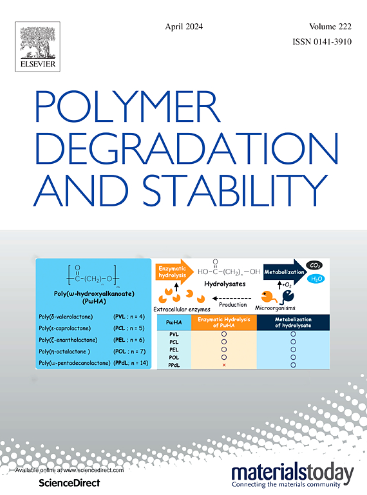Accelerated weathering of EPON-IPD thermosets reinforced with carbon black
IF 6.3
2区 化学
Q1 POLYMER SCIENCE
引用次数: 0
Abstract
This study elucidates the role of two carbon black nanofillers (V9A32 and M900) in mitigating the cyclic impact of UV and condensation on thermosetting shape memory polymer capable of high enthalpy storage of shape memory composed of EPON 826 (bisphenol A) and isophorone diamine. Samples were subjected to cyclic UV and condensation for 100, 300, 600, and 1000 h. The chemical, thermal, and morphological properties were examined. FTIR spectroscopy showed that samples prepared with V9A32 exhibited the highest chemical stability at 1000 h of exposure. Attenuated total reflectance Fourier-transform infrared microspectroscopy (µATR-FTIR) mapping was applied to visually track the surface degradation of the composites. µATR-FTIR mapping showed that carbonyl formation increases with exposure, and carbonyl preferentially forms around microcracks and inclusions. Differential scanning calorimetry results showed that the combined effect of UV and condensation leads to chain scission and plasticization, resulting in decreased glass transition temperatures. Morphological examination showed the formation of chalklike particles during the UV cycle that are washed off in the condensation cycle, resulting in weight loss with time. The results comprehensively show that carbon black improves the weathering of these epoxies.
用碳黑增强的 EPON-IPD 热固性塑料的加速老化
本文章由计算机程序翻译,如有差异,请以英文原文为准。
求助全文
约1分钟内获得全文
求助全文
来源期刊

Polymer Degradation and Stability
化学-高分子科学
CiteScore
10.10
自引率
10.20%
发文量
325
审稿时长
23 days
期刊介绍:
Polymer Degradation and Stability deals with the degradation reactions and their control which are a major preoccupation of practitioners of the many and diverse aspects of modern polymer technology.
Deteriorative reactions occur during processing, when polymers are subjected to heat, oxygen and mechanical stress, and during the useful life of the materials when oxygen and sunlight are the most important degradative agencies. In more specialised applications, degradation may be induced by high energy radiation, ozone, atmospheric pollutants, mechanical stress, biological action, hydrolysis and many other influences. The mechanisms of these reactions and stabilisation processes must be understood if the technology and application of polymers are to continue to advance. The reporting of investigations of this kind is therefore a major function of this journal.
However there are also new developments in polymer technology in which degradation processes find positive applications. For example, photodegradable plastics are now available, the recycling of polymeric products will become increasingly important, degradation and combustion studies are involved in the definition of the fire hazards which are associated with polymeric materials and the microelectronics industry is vitally dependent upon polymer degradation in the manufacture of its circuitry. Polymer properties may also be improved by processes like curing and grafting, the chemistry of which can be closely related to that which causes physical deterioration in other circumstances.
 求助内容:
求助内容: 应助结果提醒方式:
应助结果提醒方式:


